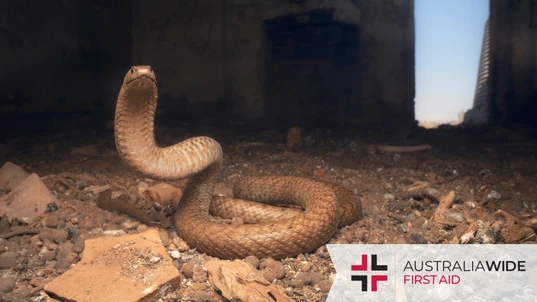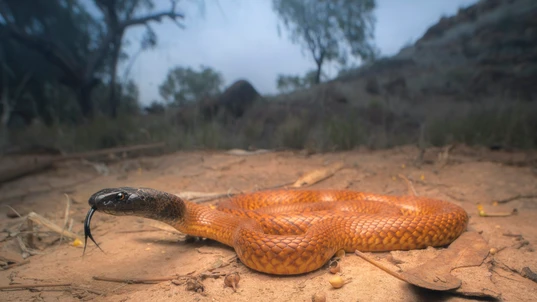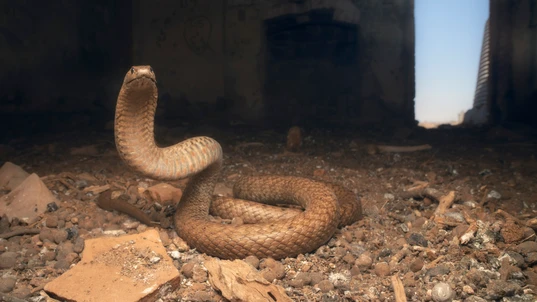The Western Brown Snake Explained

Bites and Stings

Though it's lesser known than its Eastern counterpart, the Western Brown Snake is highly dangerous to humans. Not only does it inhabit a wide variety of environments, but it is also nervous, fast-moving, and has potent venom that attacks the nervous system.
There are three different species of Western Brown Snake – at least, that we know about. There has been great confusion about how to categorise them in the past. Though it’s lesser known than the Eastern Brown Snake (Pseudonaja textilis), the Western Brown Snake is highly venomous. Like other Brown snakes, the Western brown is fast-moving, nervous, and known to inhabit a range of environments. Continue reading to learn how to identify a Western Brown, and what First Aid courses to attend for hands-on experience with managing snake bites.
The Strap-snouted Brown Snake (Pseudonaja aspidorhyncha)
Pseudonaja aspidorhyncha
Otherwise known as the Strap-snouted Brown Snake, this is a long and slender reptile with a small head that blends into the neck. The snout appears chisel-shaped from above, due in part to the enlarged rostral scale (the median plate on the tip of the snout that borders the mouth opening). Their scales are smooth and semi-glossy, and the colour and pattern on the back vary widely. Dark bands are usually present, often more noticeable on the sides and posterior half of the body. The belly is a dirty-cream, yellow, or medium brown colour, becoming lighter under the throat and chin.
An 'Orange with black head' morph of the Gwardar (Pseudonaja mengdeni)
Pseudonaja mengdeni
Sometimes referred to as Gwardar, this is a long and slender snake with a small head that blends into the neck. When viewed from above, the snout appears rounded. The scales are smooth and semi-glossy, with a particularly glossy appearance around the head and neck. The snake's colour and pattern on the back vary, but they typically fall into one of two distinct forms: the "Orange with black head" or "Pale head, grey nape" morph. The 'Orange with black head' morph of this snake has a base colour that ranges from pale to dark yellow or orange on the body, with a dark brown or black head and neck. The body typically has a black reticulated pattern that can range from fine to heavy, and there may be a series of broad, dark brown bands along the length of the body. The belly is cream or yellow and can be blotched with orange, salmon, dark brown, or grey. The 'Pale head, grey nape' morph of this snake has a base colour that ranges from pale to medium brown or yellowish, with a pale to light brown head and neck. The body typically has a fine reticulated pattern, which may be absent anteriorly. A pattern of thin, greyish-brown bands can be present, more obvious on the sides and towards the back half. Some specimens may have broad, dark brown bands interspersed with narrower bands. Typically, there is a broad darker brown or greyish-brown band on the neck, often bordered anteriorly by several black scales forming a 'V' or 'W' shape. The belly is cream or yellow, and may be blotched with orange, salmon, dark brown, or grey.
The Northern Brown Snake (pseudonaja nuchalis)
Pseudonaja nuchalis
Otherwise known as the Northern Brown Snake, this is a slender reptile with a small head that blends with the neck. The snout can be chisel-shaped due to the enlarged rostral scale, or slightly rounded. The smooth and semi-glossy scales vary in colour from light to medium brown on the body, with the head and neck sometimes being dark brown or black. Faint to distinct broad dark bands may appear on the body, and there may be scattered dark scales on the neck. The belly is cream or pale yellow with salmon blotches, while the chin is cream-coloured. It is important to note, all species of Western Brown can reach a total length of 1.5 m.Habitat and Distribution
All variations of Western Brown Snakes can be found in various arid and semi-arid habitats, such as grasslands, shrublands, savannah woodlands, dry sclerophyll forests, and pastoral areas. They are most active during the day, when they prey on lizards, fledgling birds, and small mammals. In these environments, they seek refuge under any type of ground cover, natural or man-made, including fallen timber, rock slabs, and corrugated iron sheeting. They also utilise abandoned animal burrows and deep soil cracks for shelter. The distribution of each species is only roughly known, and it varies per species. Despite their name, the Western Brown genus is not limited to Western Australia, and they can be found throughout almost the entirety of the mainland.Danger
Western Browns are highly venomous snakes. They are a nervous, fast-moving species and will quickly seek cover if available. If confronted, however, they will often adopt an "S" stance, face the threat with an open mouth, and strike before fleeing. And though they only have small fangs measuring 2-3mm, Western Brown Snake venom is highly toxic to nerve cells and red blood cells. Any Brown Snake bite should be treated as a life-threatening emergency. Call Triple Zero (000) for an ambulance and apply the Pressure Immobilisation Technique per our article on snake bite first aid.
Originally published at
https://www.australiawidefirstaid.com.au/resources/western-brown-snake
as part of the Australia Wide First Aid Articles Library









